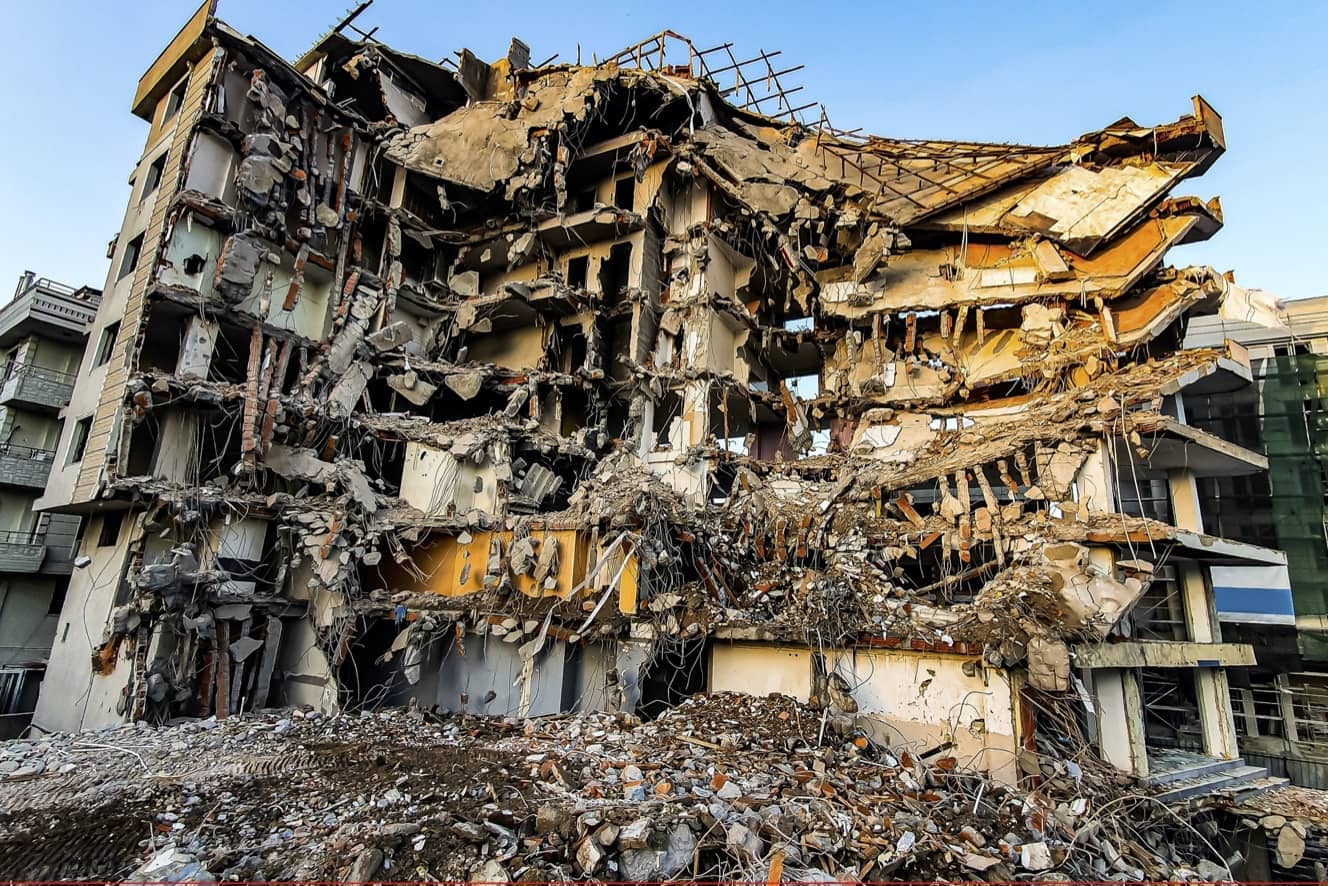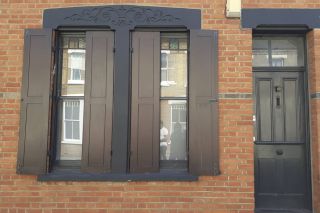
www.buildingsandcities.org/insights/commentaries/collapse-and-catastrophe.html
Collapse and Catastrophe: The Need to Protect Inhabitants

Radical changes are needed in how the construction industry operates and is regulated in order to create safe, healthy homes.
In light of the recent earthquakes in Turkey and Syria, David Oswald and Trivess Moore (RMIT University) reflect on the rights that inhabitants have for buildings to be safe, healthy, comfortable and robust. However, serial and various failings in the construction supply side and its oversight by governments mean greater accountability is needed.
The devastating earthquake that struck Turkey and Syria in February 2023 caused widespread building damage and collapse. Sadly, there were more than 50,000 fatalities and over a million people were made homeless across the region (Sariyuce 2023). It is being reported that the building quality was compromised by a government which allowed illegal buildings that did not adhere to safety regulations to be occupied (Ridgwell 2023). There is also a focus on key stakeholders in the construction industry who reportedly took shortcuts on safety and quality, with more than 200 professionals arrested on suspicion of breaching building codes (Sariyuce 2023).
Despite the tragic outcomes in Turkey and Syria, we know there are construction, engineering and urban planning solutions that significantly reduce the risk of death or injury by building collapse (Kenny 2009). While these solutions can add financial cost and be technically demanding, success has been demonstrated in various locations around the world. For example, over the last 25 years in California there have been several large earthquakes, some with magnitudes over 7 with few fatalities reported (e.g. Ridgecrest in 2019: 7.1M, 0 fatalities; Baja California in 2010: 7.2M, <5 fatalities; Hector Mine in 1999: 7.1M, 0 fatalities) (California Earthquake Authority 2023).
The catastrophic failure of the built environment within Turkey and Syria raises fundamental questions about preventing building collapse and other building defect outcomes; as well as how to respond to the unfolding humanitarian crisis and effectively, and efficiently, rebuild the built environment. These safety, health and well-being issues are not only restricted to developing countries or earthquakes. There have been other historic examples of construction failings also in the developed world (see Oswald & Moore 2022) e.g.:
- the use of asbestos causing thousands of fatalities global
- the use of flammable cladding at the Grenfell Disaster
- the widespread leaky buildings in New Zealand and Canada
- poor urban planning resulting in construction on flood plains and high-risk fire zones.
The recurrence of systemic built environment failings highlights how civil society needs to reconsider how buildings are planned, designed, constructed and maintained to provide safety, quality, and performance for the inhabitants. Building safety, quality, and performance is typically addressed by many jurisdictions through the establishment of policies to regulate minimum building standards. This approach has helped to ensure a consistent framework for the construction industry to function. However, the examples above, as well as wider issues with the prevalence of more minor defects, show that on its own, this is approach is not enough.
Unfortunately, there can be an outcome of unsafe and poor-quality buildings where the inhabitants suffer. It is time to focus more centrally on the inhabitant to improve building safety, quality, and performance outcomes. This is not only a call for consideration across the construction industry and government policymakers, but also the academic research community. There has been an abundance of research into how we can help construction companies and contractors with, for example, being efficient with production, implementing new and improved technology or with managing the safety of their workers (e.g. Sacks 2016; Sexton et al. 2006; Jin et al. 2019). While these topics are important and deserve attention, we argue that there has been a lack of focus on ensuring the inhabitant can reside in a final product that:
- is safe from collapse, fire, or other life-threatening events
- is healthy, with avoidance of dangerous materials, chemicals, and mould
- promotes well-being, and avoids stressful situations emerging from building defects
- creates social value, both within the residence and in the surrounding neighbourhood; and
- is sustainable, energy-efficient and provides comfort through building performance.
These are some of the minimum expectations that inhabitants want from a place they can call home, yet the continuous examples of construction failings in both developing and developed countries clearly show we have yet to meet these expectations in many cases.
The most concerning and fundamental challenge is to construct homes that are safe. A global push towards densification of our cities for affordability and sustainability factors has led to high-rise buildings that can be at higher risk of multiple fatality events such as collapse (e.g., Miami, US, 2021, 98 fatalities) and fire (e.g., Grenfell, UK, 2017, 72 fatalities). In terms of prevention, as noted above, there are planning, design and technology solutions to improve the safety and quality of buildings so that risk of safety issues are significantly reduced.
If we are to continue to build higher-density buildings we must ensure that improved safety measures are included as a minimum in all new buildings, and options are found to retrofit safety into existing buildings which do not meet current safety standards. There must also be improved independent checks of work to ensure outcomes are not compromised. Prevention will also require a change in how the wider construction sector operates on a system level to guarantee safety, and the practices of each stakeholder, including architects, engineers, surveyors, contractors will need to be carefully considered, to ensure building control. If improved safety is not able to be achieved in higher-density dwellings, then there could be consideration for urban design that emphasises lower-density living.
There are also rectification challenges that consumers are subject to when there is a defect, failing or fault that emerges with their building. When considering the consumer more centrally, it is clear there needs to be more robust forms of building warranty to have issues addressed in a timely manner. The ongoing cladding crisis is a high-profile example where there has been a lack of consumer protection, leaving consumers living in homes at higher fire risk, and with significant financial bills placed upon them to fix cladding (even if under warranty) (Oswald et al. 2022). This has led to disputes between owners in multiple-occupancy homes around payments; as well as causing stress and a suffering of occupant well-being (Martin & Preece 2021; Oswald et al. 2023). There is a need to improve support for timely rectification for consumers through more efficient ways of identifying defects, robust warranties, accessible legal advice, and even financial and well-being support when encountering a consumer crisis (e.g. asbestos, flammable cladding, widespread leaking buildings).
People have the right to buildings that are: safe, healthy, promote well-being, create social value, are sustainable, energy efficient and perform to provide comfort for occupants. The construction industry can achieve these societal goals, and the first step is to focus on the inhabitant more comprehensively, as opposed to only focusing on meeting minimum industry standards (and often not reaching them). There must be greater accountability for governments and those in the industry who fall short of these requirements. The challenge of establishing a residential construction sector for the consumer is one that industry, government and academia can all help contribute towards in a more considered and substantial way.
References
California Earthquake Authority. (2023). List of Notable and Major California Earthquakes. https://www.earthquakeauthority.com/California-Earthquake-Risk/California-Earthquake-History-Timeline
Jin, R., Zou, P. X., Piroozfar, P., Wood, H., Yang, Y., Yan, L. & Han, Y. (2019). A science mapping approach based review of construction safety research. Safety Science, 113, 285-297.
Kenny, C. (2009). Why do people die in earthquakes? The costs, benefits and institutions of disaster risk reduction in developing countries. Policy Research Working Paper 4823, The World Bank Sustainable Development Network Finance Economics & Urban Department.
Martin, W. & Preece, J. (2021). Understanding the impacts of the UK 'cladding scandal': Leaseholders' perspectives. People, Place and Policy, 15(1), 46-53.
Oswald, D. & Moore, T. (2022). Constructing a Consumer-focused Industry: Cracks, Cladding and Crisis in the Residential Construction Sector. Abingdon: Routledge.
Oswald, D., Moore, T. & Lockrey, S. (2022). Combustible costs! financial implications of flammable cladding for homeowners. International Journal of Housing Policy,22(2), 225-250.
Oswald, D., Moore, T. & Lockrey, S. (2023). Flammable cladding and the effects on homeowner well-being. Housing Studies, 38(3), 403-422.
Ridgwell, H. (2023). Engineers blame building amnesty for Turkey quake's high toll. VOA News. https://www.voanews.com/a/engineers-blame-building-amnesty-for-turkey-quake-s-high-toll/6995406.html
Sacks, R. (2016). What constitutes good production flow in construction? Construction Management and Economics, 34(9), 641-656.
Sexton, M., Barrett, P. & Aouad, G. (2006). Motivating small construction companies to adopt new technology. Building Research & Information, 34(1), 11-22.
Sariyuce, I. (2023). Turkey arrests nearly 200 people over alleged poor building construction following quake tragedy. CNN. https://edition.cnn.com/2023/02/26/europe/turkey-earthquake-arrests-intl/index.html
Latest Peer-Reviewed Journal Content
Acceptability of sufficiency consumption policies by Finnish households
E Nuorivaara & S Ahvenharju
Key factors for revitalising heritage buildings through adaptive reuse
É Savoie, J P Sapinski & A-M Laroche
Cooler streets for a cycleable city: assessing policy alignment
C Tang & J Bush
Understanding the embodied carbon credentials of modern methods of construction
R O'Hegarty, A McCarthy, J O'Hagan, T Thanapornpakornsin, S Raffoul & O Kinnane
The changing typology of urban apartment buildings in Aurinkolahti
S Meriläinen & A Tervo
Embodied climate impacts in urban development: a neighbourhood case study
S Sjökvist, N Francart, M Balouktsi & H Birgisdottir
Environmental effects of urban wind energy harvesting: a review
I Tsionas, M laguno-Munitxa & A Stephan
Office environment and employee differences by company health management certification
S Arata, M Sugiuchi, T Ikaga, Y Shiraishi, T Hayashi, S Ando & S Kawakubo
Spatiotemporal evaluation of embodied carbon in urban residential development
I Talvitie, A Amiri & S Junnila
Energy sufficiency in buildings and cities: current research, future directions [editorial]
M Sahakian, T Fawcett & S Darby
Sufficiency, consumption patterns and limits: a survey of French households
J Bouillet & C Grandclément
Health inequalities and indoor environments: research challenges and priorities [editorial]
M Ucci & A Mavrogianni
Operationalising energy sufficiency for low-carbon built environments in urbanising India
A B Lall & G Sethi
Promoting practices of sufficiency: reprogramming resource-intensive material arrangements
T H Christensen, L K Aagaard, A K Juvik, C Samson & K Gram-Hanssen
Culture change in the UK construction industry: an anthropological perspective
I Tellam
Are people willing to share living space? Household preferences in Finland
E Ruokamo, E Kylkilahti, M Lettenmeier & A Toppinen
Towards urban LCA: examining densification alternatives for a residential neighbourhood
M Moisio, E Salmio, T Kaasalainen, S Huuhka, A Räsänen, J Lahdensivu, M Leppänen & P Kuula
A population-level framework to estimate unequal exposure to indoor heat and air pollution
R Cole, C H Simpson, L Ferguson, P Symonds, J Taylor, C Heaviside, P Murage, H L Macintyre, S Hajat, A Mavrogianni & M Davies
Finnish glazed balconies: residents' experience, wellbeing and use
L Jegard, R Castaño-Rosa, S Kilpeläinen & S Pelsmakers
Modelling Nigerian residential dwellings: bottom-up approach and scenario analysis
C C Nwagwu, S Akin & E G Hertwich
Mapping municipal land policies: applications of flexible zoning for densification
V Götze, J-D Gerber & M Jehling
Energy sufficiency and recognition justice: a study of household consumption
A Guilbert
Linking housing, socio-demographic, environmental and mental health data at scale
P Symonds, C H Simpson, G Petrou, L Ferguson, A Mavrogianni & M Davies
Measuring health inequities due to housing characteristics
K Govertsen & M Kane
Provide or prevent? Exploring sufficiency imaginaries within Danish systems of provision
L K Aagaard & T H Christensen
Imagining sufficiency through collective changes as satisfiers
O Moynat & M Sahakian
US urban land-use reform: a strategy for energy sufficiency
Z M Subin, J Lombardi, R Muralidharan, J Korn, J Malik, T Pullen, M Wei & T Hong
Mapping supply chains for energy retrofit
F Wade & Y Han
Operationalising building-related energy sufficiency measures in SMEs
I Fouiteh, J D Cabrera Santelices, A Susini & M K Patel
Promoting neighbourhood sharing: infrastructures of convenience and community
A Huber, H Heinrichs & M Jaeger-Erben
New insights into thermal comfort sufficiency in dwellings
G van Moeseke, D de Grave, A Anciaux, J Sobczak & G Wallenborn
'Rightsize': a housing design game for spatial and energy sufficiency
P Graham, P Nourian, E Warwick & M Gath-Morad
Implementing housing policies for a sufficient lifestyle
M Bagheri, L Roth, L Siebke, C Rohde & H-J Linke
The jobs of climate adaptation
T Denham, L Rickards & O Ajulo
Structural barriers to sufficiency: the contribution of research on elites
M Koch, K Emilsson, J Lee & H Johansson
Disrupting the imaginaries of urban action to deliver just adaptation [editorial]
V Castán-Broto, M Olazabal & G Ziervogel
Nature for resilience reconfigured: global- to-local translation of frames in Africa
K Rochell, H Bulkeley & H Runhaar
How hegemonic discourses of sustainability influence urban climate action
V Castán Broto, L Westman & P Huang
Fabric first: is it still the right approach?
N Eyre, T Fawcett, M Topouzi, G Killip, T Oreszczyn, K Jenkinson & J Rosenow
Social value of the built environment [editorial]
F Samuel & K Watson
Understanding demolition [editorial]
S Huuhka
Data politics in the built environment [editorial]
A Karvonen & T Hargreaves



Latest Commentaries
Decolonising Cities: The Role of Street Naming
During colonialisation, street names were drawn from historical and societal contexts of the colonisers. Street nomenclature deployed by colonial administrators has a role in legitimising historical narratives and decentring local languages, cultures and heritage. Buyana Kareem examines street renaming as an important element of decolonisation.
Integrating Nature into Cities
Increasing vegetation and green and blue spaces in cities can support both climate change mitigation and adaptation goals, while also enhancing biodiversity and ecological health. Maibritt Pedersen Zari (Auckland University of Technology) explains why nature-based solutions (NbS) must be a vital part of urban planning and design.